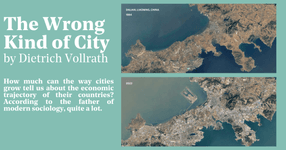Sublime
An inspiration engine for ideas
As Matt Clancey points out that “the benefits of knowledge spillovers from being physically close to other knowledge workers have been falling and may no longer exist in many domains of knowledge.” This is a controversial claim, but Clancey provides a detailed review of multiple studies that address this matter from different directions.
Dror Poleg • Dror’s Substack | Substack
Zoning is losing its power. New ventures are able to reach a meaningful scale before regulators (and competitors) react. The boundaries between different uses are blurring, with people lodging in apartment buildings, living in hotels, working in restaurants and retail malls, and sleeping or socializing at the office.
Dror Poleg • Dror’s Substack | Substack

We would now like to account for the behavior of collective growth in a system of cities and the pattern of relative fluctuations. Specifically, we would like to understand at a fundamental level the slowness and persistence of these deviations from scaling as well as get a handle on their typical magnitudes.
Luis M. A. Bettencourt • Introduction to Urban Science: Evidence and Theory of Cities as Complex Systems
The hidden cost of AI: Trading long-term resilience for short-term efficiency
Eric Markowitzbigthink.com

faster churning of companies in and out of the S&P 500, the death of news and the newspaper, the failure of established
Martin Gurri • Revolt of the Public and the Crisis of Authority in the New Millennium
‘The basic behaviour mode of the world system is exponential growth of population and capital, followed by collapse… Under the assumption that population and capital growth should not be deliberately limited but should be left to “seek their own levels”, we have not been able to find a set of policies that avoids the collapse mode of behavior.’
Richard Roberts • Limits to Growth at 50: the groundbreaking study that failed to change the world
as cities grow and their networks evolve, the area or volume of the networks needed to keep them functionally connected tends to become smaller on a per capita basis. For example, in larger cities more people can share the same bus or segment of road or sewer pipe.